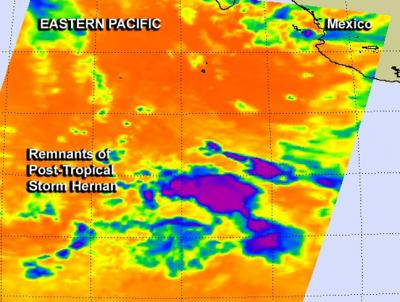NASA sees warmer cloud tops as Tropical Storm Hernan degenerates

This false-colored infrared image on July 29 at 5:11 a.m. EDT from NASA's Aqua satellite shows small, fragmented areas of a few powerful thunderstorms with high, cold (purple) cloud tops in Tropical Storm Hernan. Credit: NASA JPL, Ed Olsen
The Atmospheric Infrared Sounder or AIRS instrument aboard Aqua gathered infrared data on a quickly weakening Hernan on July 29 at 5:11 a.m. EDT.
The data was then made into a false-colored image at NASA's Jet Propulsion Laboratory in Pasadena, California. The AIRS image showed small, fragmented areas of a few powerful thunderstorms with high, cold cloud tops in Tropical Storm Hernan as it continued weakening.
For the most part, however, the cloud top temperatures warmed through the system which indicated the uplift was weaker.
By 11 a.m. EDT (1500 UTC) Hernan was no longer a tropical cyclone and had become a remnant low pressure area. The center of post-tropical cyclone Hernan was located near latitude 23.5 north and longitude 121.1 west, about 710 miles (1,145 km) west of the southern tip of Baja California, Mexico.
The post-tropical cyclone is moving toward the west-northwest near 15 mph (24 kph) and this general heading with a decrease in forward speed is expected through Wednesday night, July 30. Maximum sustained winds are near 35 mph (55 kph).
The National Hurricane Center expects that remnant low to dissipate during the next couple of days.
Media Contact
All latest news from the category: Earth Sciences
Earth Sciences (also referred to as Geosciences), which deals with basic issues surrounding our planet, plays a vital role in the area of energy and raw materials supply.
Earth Sciences comprises subjects such as geology, geography, geological informatics, paleontology, mineralogy, petrography, crystallography, geophysics, geodesy, glaciology, cartography, photogrammetry, meteorology and seismology, early-warning systems, earthquake research and polar research.
Newest articles

Trotting robots reveal emergence of animal gait transitions
A four-legged robot trained with machine learning by EPFL researchers has learned to avoid falls by spontaneously switching between walking, trotting, and pronking – a milestone for roboticists as well…

Innovation promises to prevent power pole-top fires
Engineers in Australia have found a new way to make power-pole insulators resistant to fire and electrical sparking, promising to prevent dangerous pole-top fires and reduce blackouts. Pole-top fires pose…

Possible alternative to antibiotics produced by bacteria
Antibacterial substance from staphylococci discovered with new mechanism of action against natural competitors. Many bacteria produce substances to gain an advantage over competitors in their highly competitive natural environment. Researchers…





















